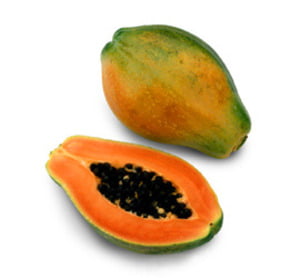I first learned about papaya fruit when I was living in Mexico. It was a preferred fruit dessert in the economical restaurants in which I was accustomed to eat.
Carica papaya is, in fact, a native plant in southern Mexico and Central America. However, it is now cultivated elsewhere in the tropics. I now live in the Philippines, and I have four papaya trees on the little land that is at my disposal. (I apply the terms “trees” and “trunks” to papaya plants, even though they differ botanically from your oaks and maples. They are handy terms to use.)
Growth Habit
Carica papaya can grow in places where the soil is only two feet deep. This I have learned from experience, since one of my papaya trees has only that much soil at its disposal.
Its shallow root system is a distinct disadvantage under certain circumstances. One of my trees blew over in a typhoon a while back. Fortunately, it was not completely uprooted. It fell against a high fence, forming a 60 degree angle with the ground. After a period of diminished fruit production, it recovered to an extent and is now bearing small but tasty fruit.
All of our trees had single straight trunks at first. The leaves grew near the top of the trunk. The leaves had large palmate lobes and long, sturdy stalks. White flowers grew in the axils of the leaves. Eventually, the flowers were superseded by fruits.
The trunk grew higher and higher; and as it grew, more leaves sprouted above the old leaves. Flowers and fruit developed in the axils of these new leaves. The older leaves at the bottom fell off one by one as the new leaves developed.
Some of the fruits fell off before they were mature. This often was the fate of newly developing fruit when the tree was already loaded with large ripening fruits.
At first, it was easy to pick the fruit. All I had to do is reach up a ways. Eventually, however, I had to use a chair, and now I have to stand up on chair and poke them down with a three foot stick.
The oldest papaya tree no longer has a straight trunk. It is curved considerably in the upper part, probably as a result of its heavy load of fruit coupled with frequent typhoons. Another one lost all its leaves a while back. Eventually it grew three branches on top, and all three developed new leaves and a few fruits. I have been told that the papaya tree develops multiple branches when the top is cut off. Perhaps the multiple branches on my plant is the result of some injury.
Dioecious Plants
Carica papaya is a dioecious plant. This means that the male flowers and the female flowers grow on two different trees. All my papayas are female plants.
The Fruit
My soil is not the best quality, but some of my fruits grew as large as a softball. The fruit is green at first. It has a green rind, technically known as the exocarp. If you cut it open before it is ripe, the edible pulp is light green.
Eventually, both rind and pulp turn orange. My papayas turn light orange, but I saw deep orange papaya pulp in Mexico.
The seeds lie in a central section of the fruit inside of the edible pulp, something like a squash. The seeds are about the size of a raisin, except that they are hard and spherical.
Uses
We usually pick the papaya when the rind is just beginning to turn orange. They ripen satisfactorily inside the house. When ripe, we eat the pulp raw or else put it in a blender and drink it as a shake. Sometimes we pick it when it is still green. The light green pulp is then cooked and served in soups.
The spicy seeds may be used as a substitute for black pepper, according to Wikipedia.
Papain
When a papaya has been picked, sticky latex oozes from the plant at the place where the fruit was broken off. This latex contains a substance called papain. This substance is used in medicine and cosmetics, but it may cause an allergic reaction. Some people are also allergic to the pollen and the fruit of papaya.
Papain is present in all parts of the plant, even the roots.
Nutritional Benefits
Papaya is a source of energy and dietary fiber. It is rich in vitamin C and vitamin E, and has many other vitamins and minerals.
References:
Purdue Horticulture, Agriculture, and Landscape Architecture: Carica papaya L.
http://www.hort.purdue.edu/newcrop/duke_energy/Carica_papaya.html
Wikipedia: Carica papaya
http://en.wikipedia.org/wiki/Carica_papaya
